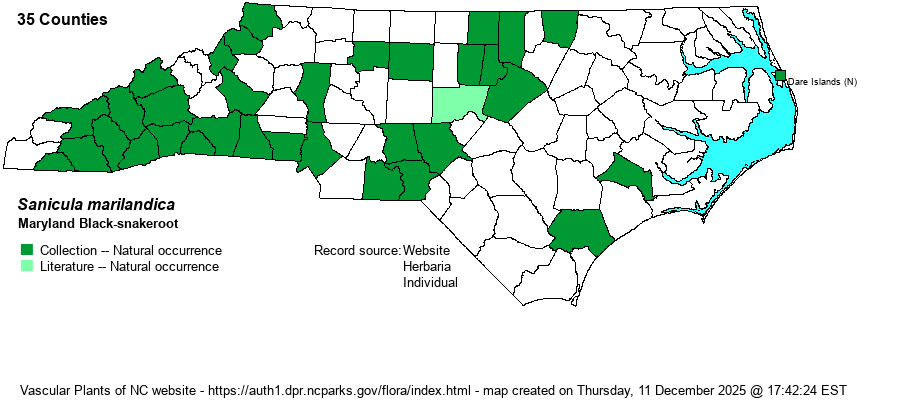| Author | L. | |
| Distribution | Nearly throughout the Mountains, but scattered across the Piedmont. Only a few Coastal Plain records, from rich forest sites in the southeastern portion.
This is a wide-ranging species, across Canada and south to northern FL and LA. | |
| Abundance | Fairy common to frequent in the Mountains, but uncommon in the Piedmont; very rare in the southeastern Coastal Plain. | |
| Habitat | This is a forest-based species, usually in rich to somewhat mesic hardwood forests. It does occur in openings and along some wooded borders. | |
| Phenology | Blooms in May and June, and fruits in July and August. | |
| Identification | This is a medium-sized herb growing to about 1.5 feet tall, like others in the genus. It has basal and alternate stem leaves, palmately-divided as with others in the group, but in this species the outermost pair of 5 leaflets tend to be strongly cleft and thus it can appear to have 7 leaflets. Other species typically have 5 leaflets. The margins are strongly serrated; each leaflet is about 2-3 inches long and 1-inch wide, oblanceolate in shape. As with the others, the very small umbels are raised high above the leaves on a long stalk. The petals are greenish white and very small, but the key is the shape of the fruit. In this species, the style extends much farther outward than do the numerous bristles on the fruit; S. odorata is the only other one that shows this. The bristles are bulbous (swollen) at the base. Check various keys for other fruit differences. Generally, the nearly 7-lobed leaflets, coupled with the very long styles sticking past the bristles, which are swollen at the base, should suffice to identify it. | |
| Taxonomic Comments | None
| |
| Other Common Name(s) | Maryland Sanicle | |
| State Rank | S4? [S3S4] | |
| Global Rank | G5 | |
| State Status | | |
| US Status | | |
| USACE-agcp | FACU link |
| USACE-emp | FACU link |

